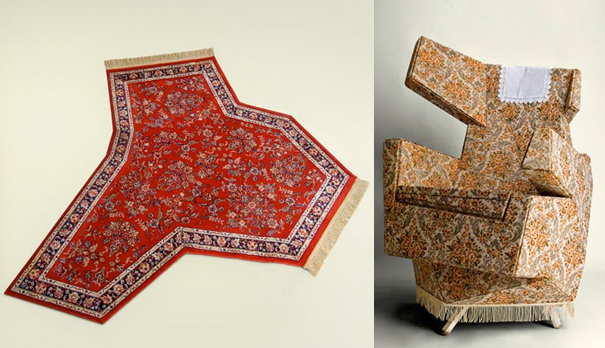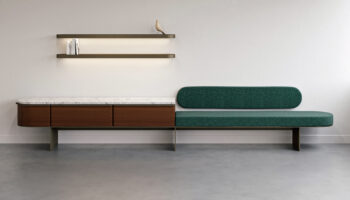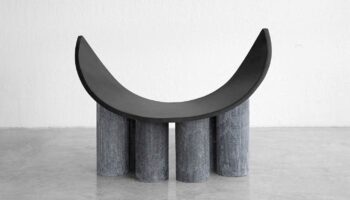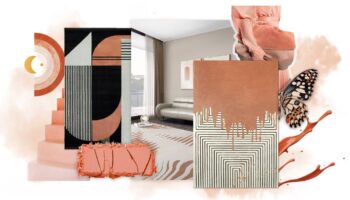Hannes Grebin’s Schrankwand
Here’s a question that’s on many a design-minded mind this week: What do we know about Hannes Grebin? Not so much, as it turns out. Via his birthplace of Rostock, Germany, Grebin studied at the Bauhaus in Weimar, before completion of internships in Stuttgart and London, followed by termination of his studies and the conferral of a degree in product design last October.
Spiesser-Sofa, couche. Designed by Hannes Grebin.
Wasting no time in getting our attention, at the end of ’08 he released the aptly named “Diploma” collection-a “retro-futuristic/Cubism meets 1970s” hodgepodge of hipster-chic. Consisting of a sofa, wingchair, rug, pair of pendant lamps, and a sideboard/cabinet, the somewhat oddball assortment certainly complies with Grebin’s design philosophy: “a complete rethink of concepts, traditions, and morality thus pushing design to other questions.” (Sometimes the slightly-skewed translation does the thought justice indeed…). After looking at these pieces-each of which feature abrupt angles, distorted spatial relationships, and an ultra-self-conscious brand of geometrical whimsy-the necessary response is, “yes, these do represent a complete rethink.”

Perser, oriental rug. Designed by Hannes Grebin.
Of this grouping, I most admire the “Schrankwand” Sideboard. Translated from the German as “wall unit,” the piece reflects the contemporary belief that “less is more.” According to Grebin: “the wall unit as a florid storage system is overtaken and substituted by a sideboard. This piece of furniture is an arrangement of four different functional parts of a rustic wall unit for the purpose of German period furniture.” Two bits of info. here I feel compelled to dissect: 1. the evolution of the wall unit to a slim-lined and hyper-functional sideboard (perhaps acknowledging such pervasive truths as rectangular rooms and flat screen TVs); and 2. The mention of German period furniture, which likely refers to the “Biedermeier.” Typifying the taste of “a well-to-do middle-class man,” this style “frequently displayed an honest simplicity in its form and decorative detail… the cabinetwork representing a ‘potpourri’ of other 19th century styles.”

Schrankwand, sideboard. Designed by Hannes Grebin.
With this in mind, one can see how “Schrankwand” is invested in the aforementioned retro-futurism. It’s really a hybrid piece that evokes both the historical evolution of cabinetry and the 70s Bauahausian insistence on spare functionality. Add to this the overt skewing of structure and shape, and Voila!-a sideboard that recognizes the pressing constraints of the contemporary age without lapsing into an uninspired functionality. And the topper? It’s reminiscent of any number of 70s cabinetry schemes (through the hazy mists of memory, I see my parents’ stereo ensemble, the shelves stuffed full with faded sleeves for bygone vinyl). My only remaining question: with a birth date of 1980, how did Grebin get this so spot on? I guess the man knows his history.




Leave a Reply